Texting ex-partners, flirting online, staying on dating apps: Survey reveals most common infidelity habits—and why cheaters do them

Gorodenkoff // Shutterstock
Texting ex-partners, flirting online, staying on dating apps: Survey reveals most common infidelity habits—and why cheaters do them
Overhead view of couple laying in bed facing away from each other in the dark while one person is scrolling on phone.
With infidelity or extramarital affairs being the cause of 34% of divorces across the U.S, it seems that, unfortunately, cheating is a more common occurrence between partners than many of us would like to admit.
To understand just how prevalent cheating and infidelity are across the country, a Spokeo survey delved into how many people admit to being unfaithful to their other halves, and the main causes for affairs.
The research surveyed 1,158 U.S. adults to understand how many have been the victims and perpetrators of cheating, and where the most common places for temptation exist. The majority, 81.6%, of those surveyed were married, 10% were in a committed relationship and 5% were single and never married.
Key findings
- More than two in five of respondents surveyed (44.3%) have cheated on their partner.
- The most common reason given for cheating was ‘I liked the attention’ (22.1%).
- One in five (20.4%) cheated on their partner because they suspected their partner of cheating – the second most common reason.
- Among the survey respondents, nearly one in five have signed up for a dating app (18.7%) while in a relationship.
- Almost a quarter (23.7%) of respondents have gone through their partner’s phone and messages.
- Unfaithful partners are most likely to cheat with an ex-partner (20.9%), even if respondents are most tempted to cheat with their co-workers (38.4%).
- Over half (54.5%) believe a relationship can recover from cheating.
![]()
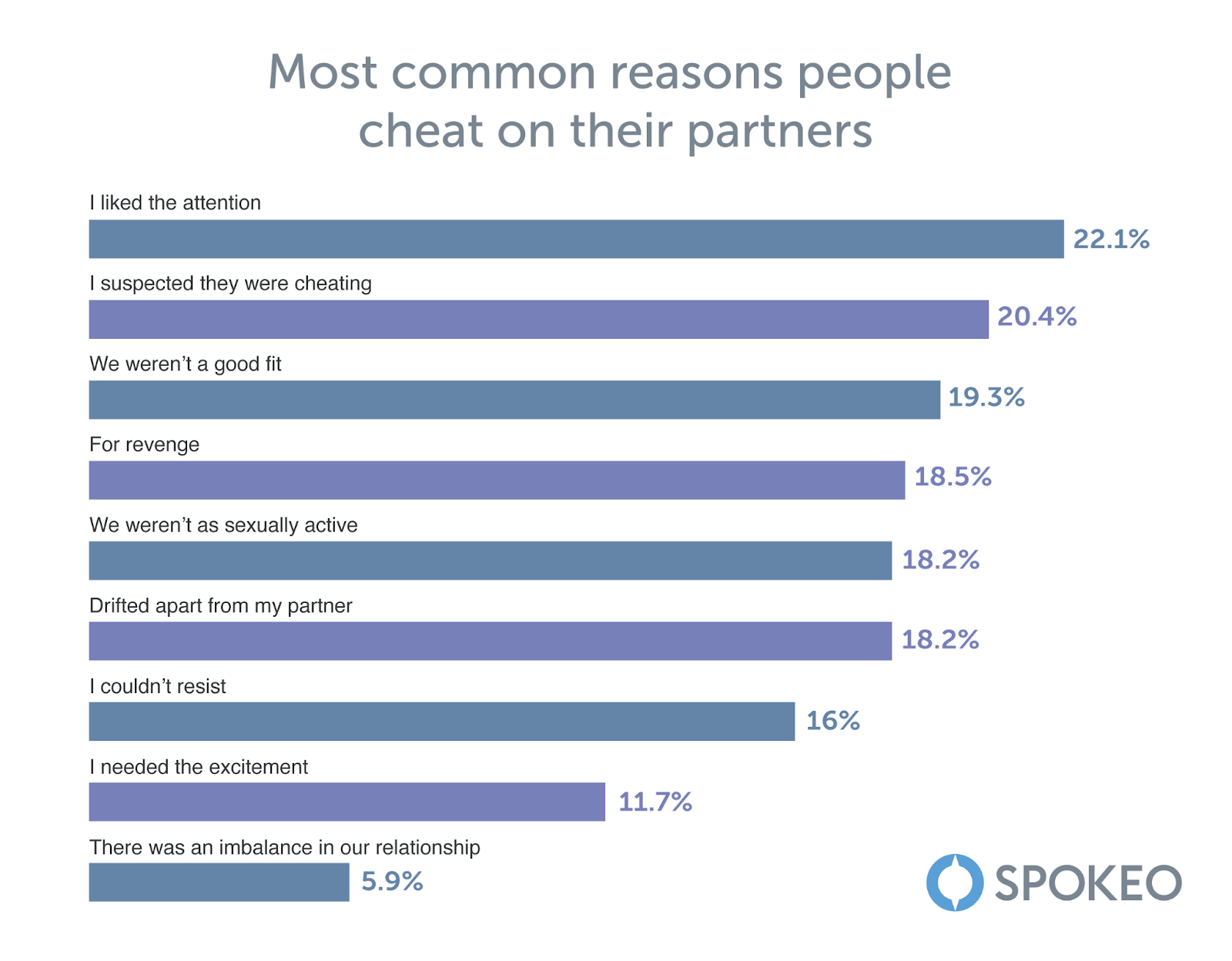
Spokeo
Over half of survey participants have been the victims of cheating
A graph chart showing results to the most common reasons people cheat on their partners.
The survey results found that, shockingly, over two in five (44.3%) admit to cheating on an existing or previous partner, while half (50%) have been the victim of cheating or suspect they have been cheated on.
When asked what drove the participants to cheat on their partners, over one in five (22.1%) admitted it was due to liking the attention given by the third party, while 20.4% admitted their infidelity was due to them suspecting their partners were cheating or had cheated on them. A further 18.5% had an affair for revenge.
Other excuses provided by the respondents included immaturity and military deployment.

Spokeo
Participants offer various excuses for cheating
A graph chart showing results to what people consider as cheating.
Almost one in five would define liking or responding to messages as cheating. What is defined as acceptable or unacceptable by partners differs among couples, and it is important to understand what the boundaries are for each relationship. To understand what would be considered as cheating, the survey provided respondents with a range of scenarios and asked them what would be classed as being unfaithful.
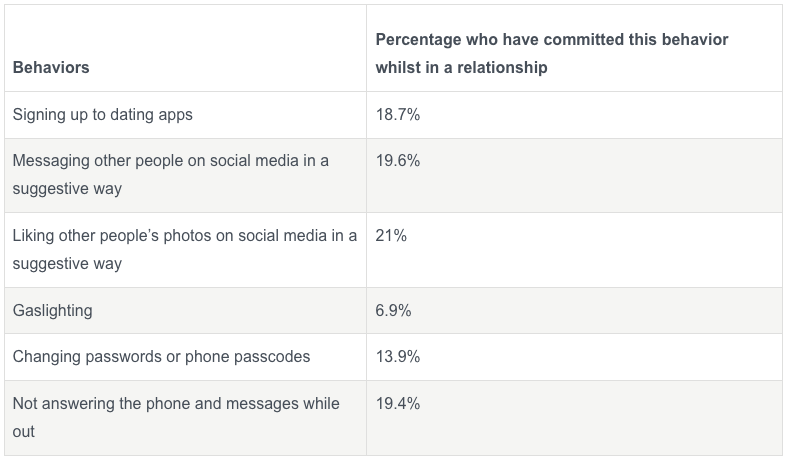
Spokeo
Nearly one in five respondents signed up for a dating app while in a relationship
A table showing results to behaviors and percentage of who have committed this behavior while in a relationship.
Outside of physical acts, the research survey looked at other behaviors from both cheating or suspecting partners to understand what they find unacceptable, and how many admit to practicing these behaviors while being in a relationship.
Signing up to dating apps was the most frowned upon activity, with over a third (34.4%) claiming that it would be unacceptable from someone they were in a relationship with – however, a shocking 18.7% admitted to signing up to one while in a relationship.
Messaging someone on social media in a suggestive way was the second most unacceptable activity, with 32.4% of the 1,000 respondents finding this unacceptable. Unfortunately, almost one in five (19.6%) admit to sending messages on a social network.
While nearly one in five (19.4%) admit to not answering their phone and messages while out, 16.8% found this behavior unacceptable.
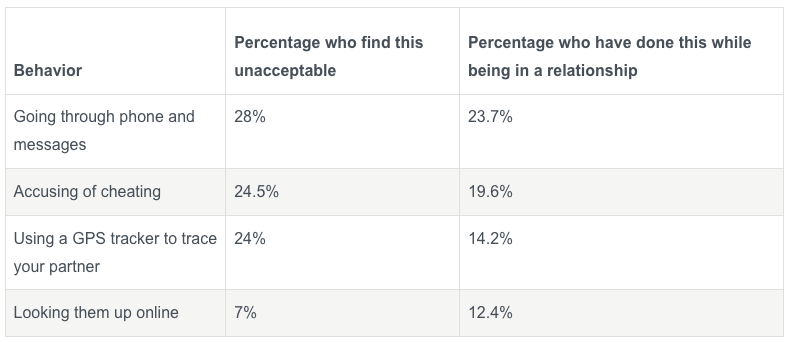
Spokeo
What behavior is acceptable to check a partner’s fidelity?
A table showing results to behaviors, percentage who find this unacceptable and percentage who have done this while being in a relationship.
Almost a quarter of respondents have gone through their partner’s phone and messages
With the survey finding that cheating has affected half of couples, it is unsurprising that around a quarter (23.7%) have tried to find evidence of infidelity by going through their partner’s phone and messages – although this activity should be approached with caution, as 28% of those surveyed would find this unacceptable behavior.
Some suspecting partners have taken their suspicions one step further, with 14.2% using a GPS tracker to trace their partner, and 6.8% admit to employing a private detective to uncover infidelities. Looking up a partner online was the most accepted behavior, with 93% respondents claiming they would find this acceptable. Interestingly, just one in eight of the respondents (12.4%) admit to doing this.

Spokeo
Unfaithful partners are most likely to cheat with an ex partner
A graph chart showing results to the main third parties for infidelities.
When those who cheated on their partner were asked who the third party was, one in five (20.9%) seemingly have gone back to the familiarity of an ex-partner. Work colleagues (18.4%) and someone they met online (18.3%) were also popular choices for those tempted into an affair.
Interestingly, work colleagues topped the poll for the group people were most tempted to cheat on their partner with. Since many U.S. adults spend around 40 hours a week with their colleagues, it is no surprise that emotional and, sometimes, physical connections are built.
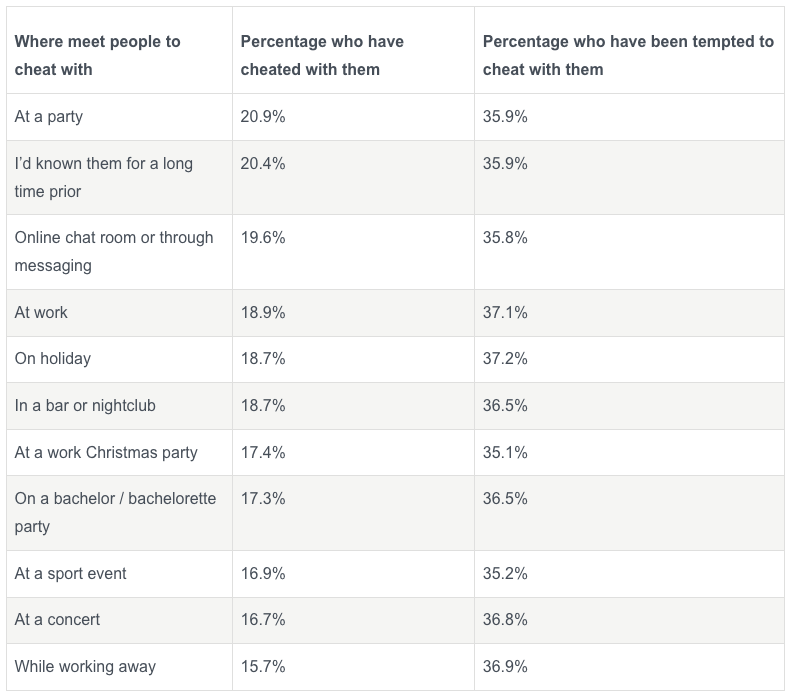
Spokeo
Survey participants say they are most likely to cheat at a party
A table showing results to where meet people to cheat with, percentage who have cheated with them, and percentage who have been tempted to cheat with them.
When the survey respondents were asked where the cheating took place, one in five (20.9%) were unfaithful at a party, with online chat rooms (19.6%) and at work (18.9%) also hotspots for cheating. People were most tempted to cheat while on holiday, with over a third (37.2%) admitting they have thought about cheating on a partner while away from home.
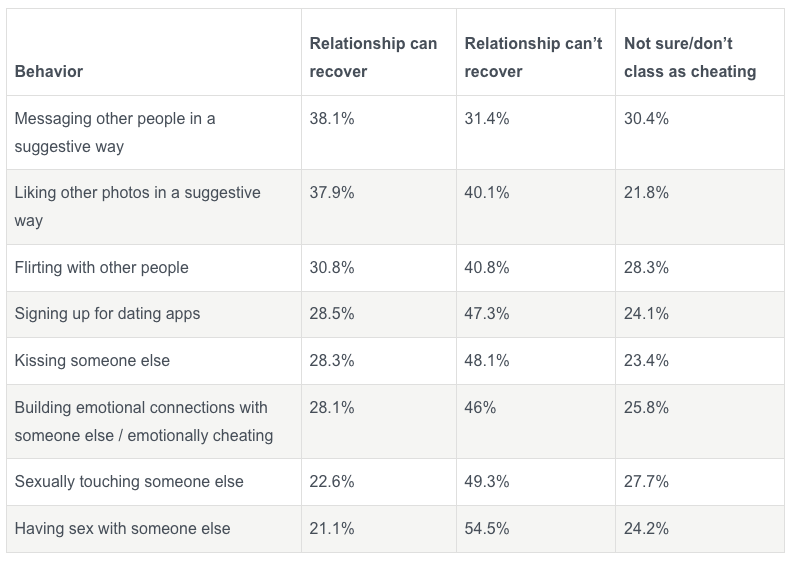
Spokeo
Over half of respondents (54.5%) believe a relationship can recover from cheating
A table showing results to behavior, relationship can recover, relationship can’t recover and not sure/don’t class as cheating.
When asked if they thought a relationship can recover from one of the partners cheating, over half (54.5%) believe that it is possible to get the partnership back on track. In fact, two in five (40.1%) claim that a relationship has survived cheating. Three in ten (31.7%) relationships couldn’t survive the trust being broken, while just under one in ten (9.4%) of partners didn’t find or hadn’t found out about the extramarital affairs.
However it seems that it is possible to forgive some behaviors more than others. Nearly two in five (38.1%) felt like they could forgive a partner messaging other people in a suggestive way, less than a third could forgive them if they signed up for a dating app (28.5%) or kissed someone else (28.3%). Unsurprisingly, having sex with another person was the behavior that most people felt a relationship couldn’t recover from, with over half (54.5%) believing a relationship can never recover from that.
Methodology
For this survey, Spokeo asked 1,158 Americans through Amazon’s survey platform in October 2023 about topics relating to relationships and infidelity. Of those surveyed, 81.6% were married, 10% were in a committed relationship and 5% were single and never married. Over three-quarters (77.8%) are parents.
The breakdown of the people surveyed was as follows:
Age Ranges:
- 18-24 – 4%
- 25-34 – 37%
- 35-44 – 44.7%
- 45-54 – 8.3%
- 55-64 – 4.2%
- 65+ – 1.6%
Gender:
- Female – 44%
- Male – 54.9%
- Non-binary – 0.9%
This story was produced by Spokeo and reviewed and distributed by Stacker Media.
